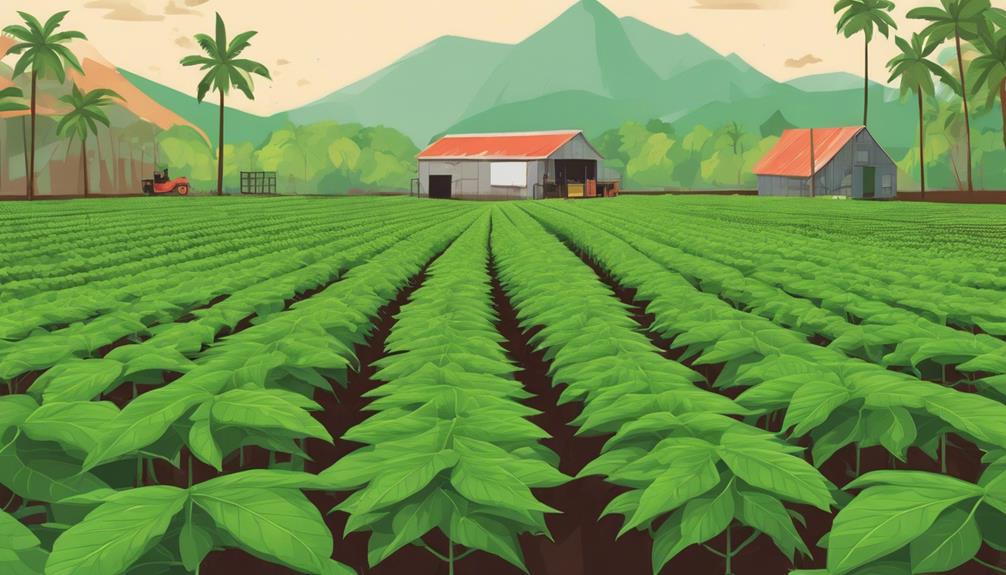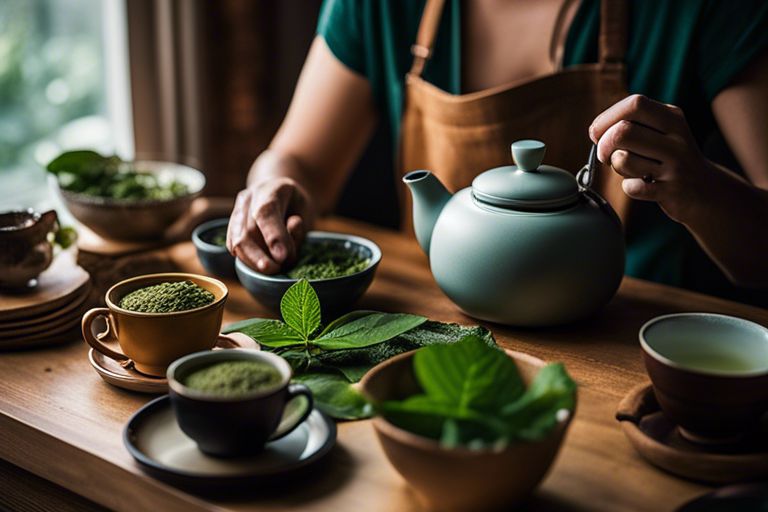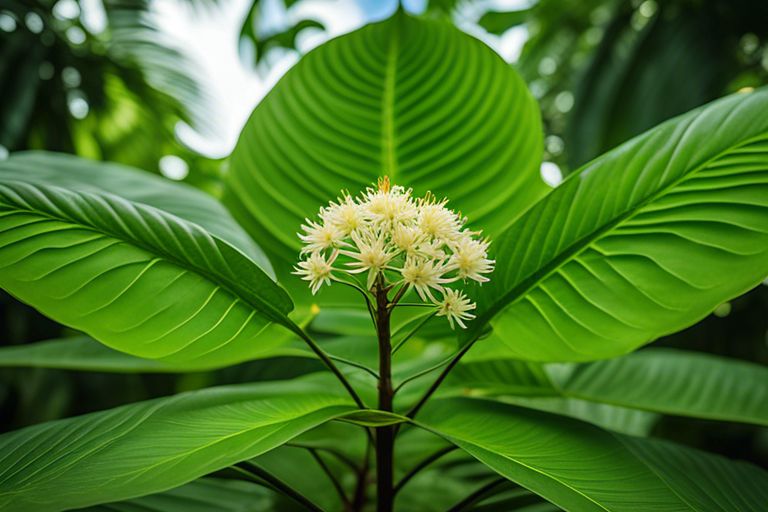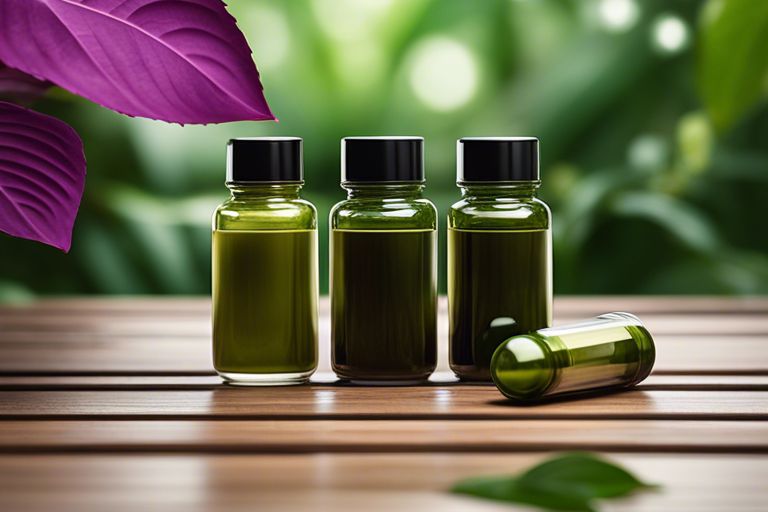Deprecated: mb_convert_encoding(): Handling HTML entities via mbstring is deprecated; use htmlspecialchars, htmlentities, or mb_encode_numericentity/mb_decode_numericentity instead in /home/users/kratomfiles/www/kratomfiles.com/wp-content/plugins/quick-adsense-reloaded/includes/template-functions.php on line 3552
So, you're intrigued by the idea of running a Kratom farm. The process involves more than just planting trees; it requires a holistic approach that encompasses various facets of farming. From understanding the intricacies of cultivation to maneuvering through legal frameworks and market dynamics, there's a lot to ponder. But what are the key factors that can truly make a Kratom farm successful? Let's explore the nuances that go beyond the surface of this fascinating industry.
Key Takeaways
- Ensure optimal growing conditions with proper sunlight, water, nutrients, and pH levels.
- Implement effective harvesting and processing techniques for high-quality leaves.
- Stay informed on legal regulations and compliance for a successful operation.
- Monitor market trends and adapt to consumer demands for profitability.
- Focus on quality control, customer satisfaction, and strategic business planning.
Understanding Kratom Farming Basics
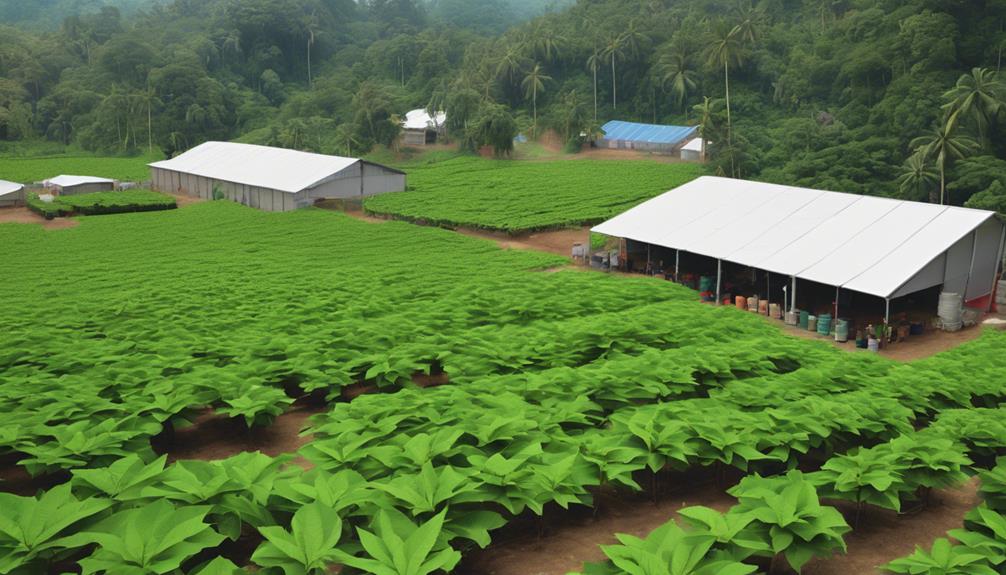
Understanding the basics of cultivating Mitragyna speciosa trees for their leaves is essential in successful kratom farming. Kratom, a tropical tree native to Southeast Asia, is known for its alkaloid-rich leaves that are prized for their medicinal and recreational properties. To grow kratom successfully, you must provide the right conditions for the trees to thrive. Kratom trees require a humid environment with well-draining soil rich in organic matter. They thrive in partial sunlight, mimicking their natural habitat under the canopy of the forest. Adequate water, balanced nutrients, and proper pH levels are critical for optimal leaf production.
The leaves of the Mitragyna speciosa tree are the primary reason for cultivation. These leaves contain alkaloids such as mitragynine and 7-hydroxymitragynine, which are responsible for the effects associated with kratom consumption. Harvesting the leaves at the right time and using appropriate processing techniques ensure the quality and potency of the final product. By understanding the intricacies of growing kratom and caring for its leaves, you can cultivate a successful kratom farm.
Legal Considerations for Kratom Farming
Before starting on your kratom farming journey, it is crucial to understand the regulatory compliance requirements, licensing, and permits necessary for cultivating this botanical crop. Familiarize yourself with the specific laws and regulations in your area to guarantee full compliance with legal standards. Proper documentation and adherence to legal frameworks are essential for the successful and lawful operation of your kratom farm.
Regulatory Compliance Requirements
To guarantee compliance with legal requirements in the cultivation of kratom, thorough research and meticulous attention to regulatory standards are imperative. Kratom cultivation regulations vary between federal, state, and local levels, necessitating a detailed understanding of each jurisdiction's mandates. Legal compliance is paramount, encompassing licensing, permits, and adherence to labeling requirements to operate a kratom farm within the confines of the law. Quality control measures must be rigorously implemented to ensure that the product meets legal standards and aligns with consumer safety expectations. Staying abreast of evolving laws and regulations concerning kratom cultivation is essential to maintain regulatory compliance. Seeking guidance from legal experts specializing in agricultural regulations can assist in navigating the intricate legal landscape of kratom farming.
Licensing and Permits
Securing the necessary agricultural permits and licenses is crucial for the legal operation of a kratom farm. To guarantee compliance with regulations, consider the following:
- Local Regulations: Research and adhere to specific requirements set by local authorities for operating a kratom farm.
- State Permits: Obtain state-level permits that may be necessary based on the size and production scale of your farm.
- Federal Licensing: Explore federal licensing needs and secure any required permits for a lawful kratom farm operation.
- Legal Guidance: Seek advice from legal professionals or agricultural experts to ensure full compliance with licensing and permit regulations.
Pros and Cons of Kratom Farming
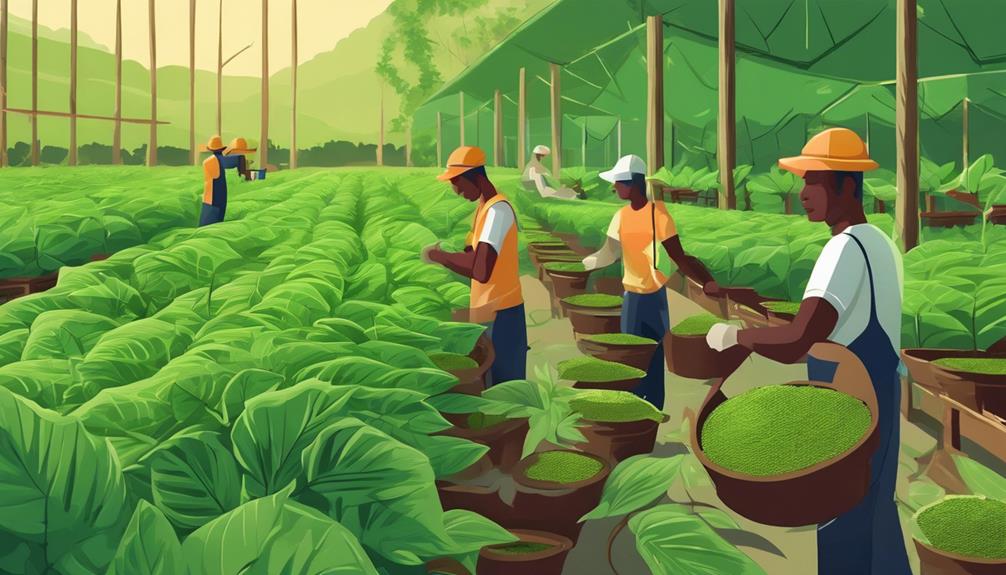
When considering the yield potential of kratom farming, it's important to analyze the labor-intensive cultivation methods required for best growth. Additionally, fluctuations in market demand can greatly impact the profitability of your farm. Balancing these factors is essential in making informed decisions for your kratom cultivation venture.
Yield Potential Analysis
Kratom farming boasts a remarkable potential for high yields, attributed to the tree's substantial size and exceptional leaf production capacity. When considering the yield potential of a kratom farm, it is essential to weigh the following factors:
- Tree Maturity: Older kratom trees tend to produce larger quantities of leaves, increasing overall yield.
- Soil Quality: Well-fertilized soil rich in nutrients can enhance leaf production and alkaloid content.
- Climate Conditions: Ideal temperature and humidity levels support healthy growth and robust leaf development.
- Pruning Techniques: Proper pruning practices can stimulate new leaf growth and improve the overall yield of alkaloid-rich leaves.
Labor-Intensive Cultivation Methods
Considering the intricate care demands of labor-intensive cultivation methods in kratom farming, a meticulous approach to plant maintenance is essential for achieving peak yields and product quality. Personalized care is a vital aspect of labor-intensive cultivation, allowing for tailored attention to each plant's needs. While the process requires significant time and effort, the hands-on approach offers advantages such as better control over plant development and alkaloid content. This level of involvement can lead to premium product outcomes, satisfying both the farmer and consumer. By handpicking leaves, closely monitoring plant health, and adjusting growth conditions as needed, farmers can guarantee the best possible results from their kratom plants.
| Pros | Cons |
|---|---|
| Personalized care for each plant | Significant time investment |
| Better control over plant development | Requires considerable effort |
| Higher quality yields | Labor-intensive maintenance |
| Premium product outcomes | Time-consuming adjustments |
| Satisfaction in farming process | Potential for fatigue |
Market Demand Fluctuations
In the domain of kratom farming, managing market demand fluctuations presents both opportunities and challenges for farmers.
- Understanding Market Trends: Staying informed about shifts in demand and supply dynamics is essential for making informed farming decisions.
- Adapting to Consumer Behavior: Tailoring cultivation practices to meet evolving consumer preferences can help maintain a competitive edge.
- Seizing Profitable Periods: Capitalizing on peak demand periods allows farmers to maximize profitability and sales.
- Mitigating Risks: Diversifying product offerings and exploring niche markets can help buffer the farm against the impacts of fluctuating demand.
Essential Tips for Kratom Cultivation
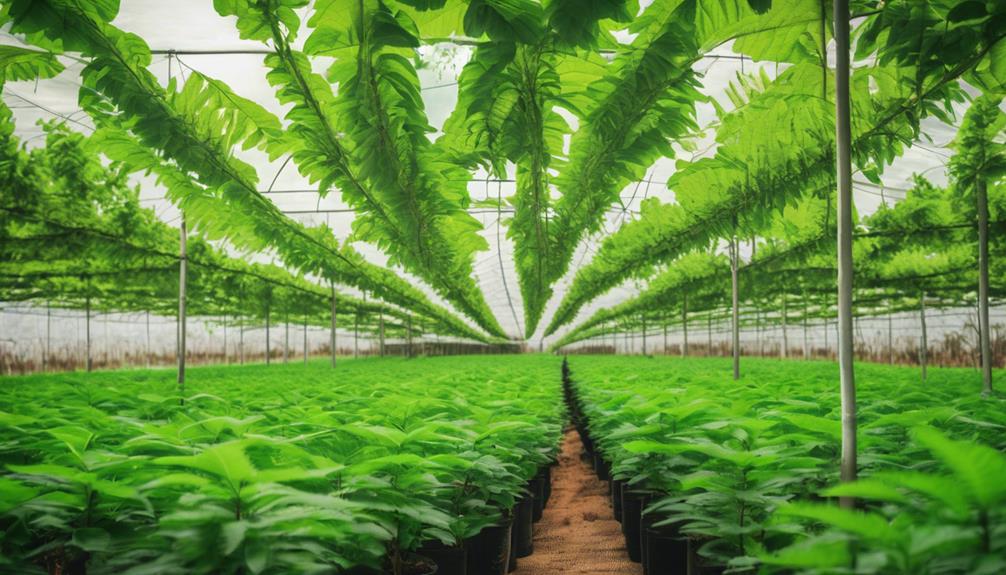
When cultivating Kratom, ensuring the correct environmental conditions is essential for successful growth and leaf development. Selecting the right strain that suits your climate is important to optimize growth and leaf production. Providing ample sunlight, water, nutrient-rich soil, and appropriate fertilizer is necessary to support healthy Kratom tree development. Regular monitoring for pests and diseases is crucial to prevent any potential damage to your Kratom plants. Harvesting the leaves at the right maturity stage is key to maximizing the alkaloid content and potency of your yield. Implementation of techniques such as using cuttings and humidifiers can aid in achieving faster growth and promoting better overall plant health.
| Environmental Conditions | Tips for Kratom Cultivation |
|---|---|
| Select the right strain | Provide adequate sunlight |
| Optimize growth and leaf production | Ensure nutrient-rich soil |
| Monitor for pests and diseases | Harvest leaves at maturity |
| Prevent damage to plants | Implement growth techniques |
| Maximize alkaloid content | Promote plant health |
Starting Your Kratom Business
To establish a successful Kratom business, it is crucial to forge strategic partnerships with established vendors in the industry. Here are some key steps to kickstart your kratom business:
- Collaborate with a Kratom Vendor: Partnering with a reputable kratom vendor can provide you with distribution deals, helping you to quickly launch your business and reach a wider market.
- Gain Experience with a Reputed Brand: Consider partnering with a well-known brand in the kratom industry for a franchise opportunity. This collaboration can offer valuable experience and insights into running a successful business.
- Establish Your Own Brand: After gaining experience through partnerships, it's time to create your own brand. Utilize the knowledge and connections gained to develop a unique brand identity in the kratom market.
- Build Brand Presence: Use the established name and distributor access to distribute kratom products under your company's name. This will help in building brand presence and recognition among consumers in the industry.
Key Legal Terms for Kratom Farmers

Understanding the legal landscape surrounding Kratom cultivation is paramount for farmers to navigate regulatory requirements effectively. Compliance with industry standards like the Kratom Consumer Protection Act and FDA regulations is vital for operating a successful Kratom farm. Familiarize yourself with labeling requirements, product descriptions, and marketing restrictions to guarantee your Kratom products meet legal standards. It is essential to include necessary legal disclaimers on your website when selling Kratom products to protect both your business and consumers. Stay informed about changing laws and regulations concerning Kratom farming by seeking legal assistance and staying up-to-date with industry news. Working within the legal framework of the Kratom business is key to avoiding legal issues and maintaining compliance.
| Legal Term | Description | Importance |
|---|---|---|
| Kratom Consumer Protection Act | Regulates the production and sale of Kratom products to ensure consumer safety and quality. | Ensures product quality |
| FDA Regulations | Guidelines set by the FDA governing the manufacturing, labeling, and distribution of Kratom. | Compliance with authorities |
| Legal Disclaimers | Statements that limit your liability and inform customers about the proper use of Kratom. | Protects your business |
Source Selection for Kratom Farming
When selecting a source for your kratom farm, it is important to take into account the best soil types for ideal growth and development of the plant. Climate conditions play a significant role in determining the success of your kratom cultivation, so choose a location that meets the specific requirements of the plant. Understanding the watering frequency needs of kratom plants is essential to make sure they receive adequate moisture without being overwatered, promoting healthy growth and leaf production.
Best Soil Types
For successful kratom farming, selecting soil with ideal characteristics is essential for the health and growth of kratom trees. When considering the best soil types for your kratom farm, keep in mind the following key factors:
- Well-Draining Loamy Soil: Kratom trees require soil that drains well to prevent waterlogging, ensuring proper oxygenation of the roots.
- High Organic Content: Opt for soil rich in organic matter to provide essential nutrients for the kratom trees' development.
- Acidic to Neutral pH Levels: Aim for a soil pH range between 5.5 to 6.5 to support healthy growth and nutrient absorption.
- Good Water Retention: Sandy loam soil with good water retention properties can help maintain adequate moisture levels for thriving kratom plants.
Climate Conditions Needed
In the cultivation of kratom, sourcing the right climate conditions is vital for the successful growth and development of these tropical trees. Kratom trees require hot and humid tropical climates with consistent rainfall to thrive. Maintaining an ideal temperature range between 75–90°F indoors is essential to mimic their native environment. These plants flourish in areas with high humidity levels of around 70% or higher. Adequate lighting is essential for successful kratom cultivation; using HPS lamps or LED bulbs can provide the necessary light intensity. When creating a conducive environment for kratom farming, factors like soil quality, ventilation, and appropriate containers must not be overlooked. Make sure that your growing conditions are well-suited to meet the needs of these unique plants.
Watering Frequency Requirements
Sourcing the right source for watering your kratom farm is essential to guarantee the proper maintenance of soil moisture levels necessary for the best growth of these tropical trees. When considering the watering frequency requirements for kratom trees, keep in mind the following important tips:
- Regular Watering: Kratom trees require frequent watering, typically every 2-3 days, to maintain ideal soil moisture levels for growth.
- Root Development: Adequate watering frequency is vital for young kratom plants to establish healthy root systems and support leaf development.
- Avoid Extremes: Over-watering can lead to root rot and other issues, while under-watering can stunt growth and affect the overall health of the tree.
- Environmental Factors: Watering needs may vary based on environmental conditions, such as temperature, humidity, and soil composition, requiring regular monitoring.
Importance of Digital Marketing
When operating a kratom farm, understanding the importance of digital marketing becomes essential in establishing a competitive edge in the industry. To enhance your online presence, it is crucial to utilize SEO techniques and social media platforms effectively. A well-designed website plays a crucial role in increasing visibility and attracting more customers to your kratom farm. Implementing email marketing campaigns and affiliate strategies can drive business growth and foster customer engagement. Building a strong online brand image is vital to establish credibility and trust with consumers in the digital world. By utilizing various digital marketing tools, you can effectively promote your kratom farm and products, thereby boosting sales and expanding your customer base. Embracing these digital marketing strategies will not only set you apart in the industry but also help you thrive in the competitive market of kratom farming.
What are the regulations for running a kratom farm in Utah?
The kratom legal status in Utah is currently legal, but there are regulations in place for running a kratom farm. Anyone looking to start a kratom farm in Utah must adhere to the state’s agricultural and business regulations, ensuring compliance with licensing, cultivation, and distribution of kratom products.
Growing Your Own Kratom Tree
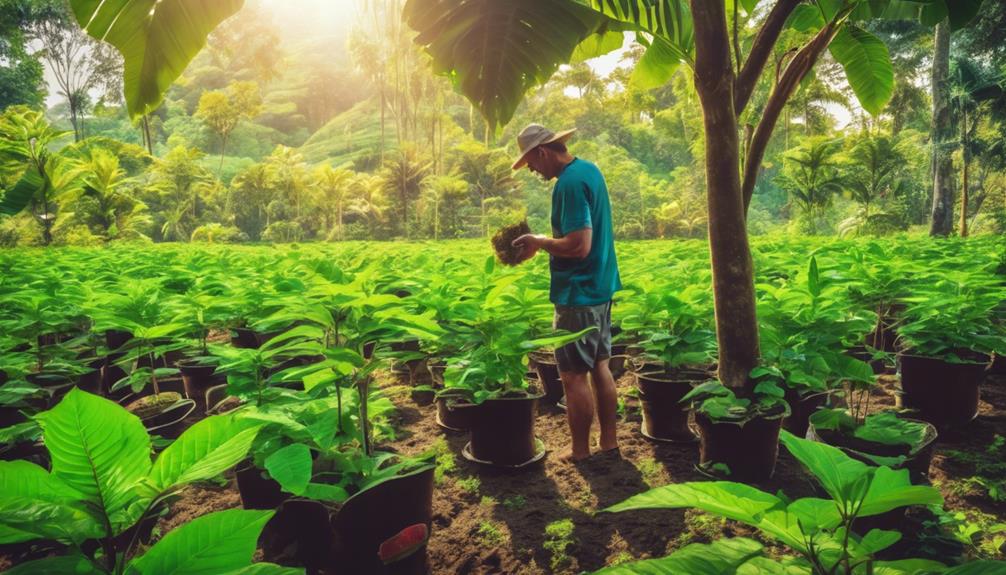
Cultivating a Kratom tree necessitates meticulous attention to soil composition and environmental conditions conducive to ideal growth. When growing your own Kratom tree, consider the following key factors:
- Selecting the Right Location: Choose a site with well-draining soil and partial shade to mimic the tree's native habitat.
- Improving Soil Conditions: Guarantee the soil is fertile with high humus levels and a pH range of 5.5-6.5 for best nutrient uptake.
- Maintaining Adequate Moisture: Kratom trees require consistent moisture levels, so water regularly to prevent drought stress.
- Monitoring Temperature and Humidity: Keep the tree in a warm, humid environment, ideally between 75-85°F with 70-90% humidity to support growth.
How Can Running a Kratom Farm Benefit Men’s Health?
Running a kratom farm can benefit men’s health in various ways. Engaging in physical labor and outdoor activities such as farming can contribute to better physical fitness and overall well-being. Additionally, consuming kratom for its various medicinal properties can help address specific health issues, leading to improved men’s health. Kratom uses for men can include managing pain, reducing stress and anxiety, improving focus, and enhancing energy levels.
Key Factors in Kratom Tree Care
To ensure the successful growth and development of your Kratom tree, meticulous attention to key care factors is essential. Kratom trees thrive in tropical climates characterized by consistent rainfall, providing the necessary moisture for their best growth. Ensuring proper soil management is vital, with a focus on maintaining high humus levels and a neutral pH range between 5.5 and 6.5 to support the health of the kratom trees. Some growers prefer nutrient-rich environments like hydroponic systems to promote the ideal conditions for kratom growth. These trees are heavy feeders, requiring regular nutrient supply, particularly nitrogen, phosphorus, and potassium, to thrive and produce high-quality leaves. Patience is crucial as kratom trees typically take two or more years to mature, necessitating careful harvesting of mature leaves to obtain a desirable yield. By prioritizing these key factors in kratom tree care, you can enhance the overall health and productivity of your cultivation efforts.
Advanced Techniques for Kratom Growth
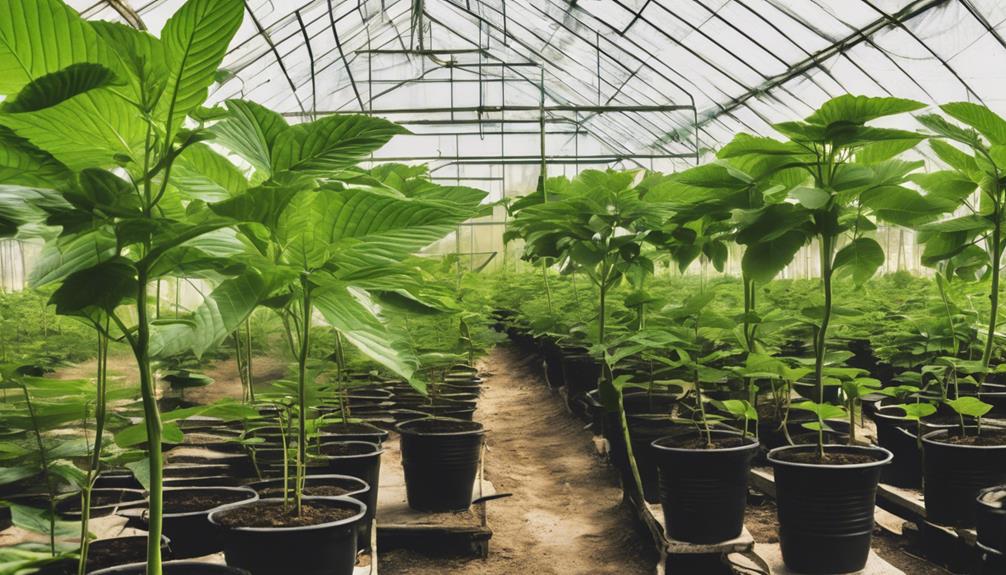
Advanced cultivation techniques can greatly impact the growth and development of Kratom plants, leading to improved yield and quality. To enhance your Kratom farm, consider the following advanced techniques:
- Tissue Culture Propagation: By employing tissue culture techniques, you can achieve faster and more consistent growth of Kratom plants, ensuring a more efficient production process.
- Controlled Environment Agriculture (CEA) Methods: Utilizing hydroponics or aeroponics in a controlled environment can optimize nutrient uptake and overall plant growth, providing a stable and controlled setting for your Kratom trees to thrive.
- Specialized Lighting Systems: Incorporating LED grow lights can mimic natural sunlight, enhancing photosynthesis processes and promoting healthier growth in your Kratom plants.
- Grafting and Cloning Techniques: Experimenting with grafting and cloning methods can help produce genetically identical Kratom plants with desired traits, ensuring consistency in quality and characteristics across your plantation.
